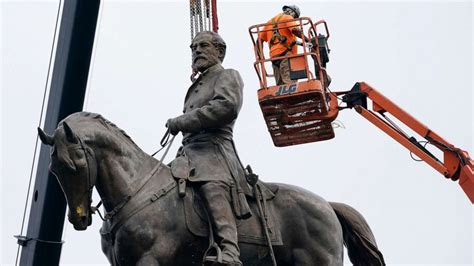
As an African American Libertarian, my perspective on the preservation of monuments differs from the commonly accepted viewpoints within the black community. I believe it is important for all voices, including those diverging from the mainstream narrative, to be heard and considered. I recognize that black people are not a monolithic group, and we should not be confined to a single way of thinking. While acknowledging the country’s long road towards true freedom and equality, I disagree with the notion that destroying statues and monuments representing racism and bigotry in our history is the most effective way to address these issues.
From Pedestals to Pavement: The Contemporary Wave of Dismantling Monuments
In recent years, there has been a surge in the tearing down of statues and monuments across the United States. This has resulted in the removal or defacement of numerous statues and memorials, especially those associated with figures who have been identified as proponents of racism, slavery, and oppression. While the intentions behind these acts may be well-meaning, it is crucial to critically examine whether this approach serves our country’s best interests in the long run.
This wave of monument removals signifies more than just an aesthetic change in our public spaces. It reflects a profound shift in societal attitudes towards historical figures and the narratives we choose to honor. Many argue that these actions are a necessary step towards confronting the harsh realities of our past and making amends for historical injustices.
However, while the intentions behind these actions are often rooted in a desire for justice and equality, it’s important to scrutinize the implications of this trend. Some critics suggest that removing these monuments might inadvertently lead to a form of historical erasure, whitewashing the complexities of our past. They argue that these statues, however problematic, serve as tangible reminders of our history, providing opportunities for education and dialogue.
Moreover, it’s worth considering what should replace these monuments once they’re gone. Do we leave these spaces empty, or do we erect new symbols that better reflect our society’s evolving values? And who gets to decide what those values are?
Ultimately, the current trend of tearing down statues and monuments raises important questions about how we choose to remember our past, who we honor in our public spaces, and how we navigate the fine line between acknowledging historical realities and perpetuating harmful narratives. As we continue to grapple with these issues, it’s crucial that we approach them with thoughtfulness, respect, and a commitment to fostering understanding and reconciliation.
A Questionable Trend: Is It Truly Beneficial for Our Nation or Black People
The recent removal of the statue of General Robert E. Lee in Charlottesville, Virginia, a symbol of the Confederacy, has sparked widespread debate about the role of such monuments in our society. The bronze equestrian statue, which once stood as a reminder of a painful past, was melted down after a protracted legal battle and is set to be repurposed for a public art installation.
While this action may seem like a significant stride towards addressing racism in America, it’s essential to examine its actual impact on the black community. Tearing down a statue, even one that represents a controversial figure, does not directly address the underlying socio-economic challenges faced by many within the black communities.
Removing a statue does not create more jobs for black individuals, improve their economic conditions, or reduce the high rates of incarceration among black people. It doesn’t confront systemic issues like racial wealth disparity, educational inequality, or healthcare disparities. These are deep-rooted problems that require comprehensive policy changes and substantial investments rather than symbolic gestures.
While the intention behind the removal and repurposing of such monuments is commendable, it’s crucial to ensure that these actions do not overshadow the more pressing issues that need our attention. Addressing the symptoms of a problem without confronting its roots can lead to superficial solutions. In this case, the actual needs of black communities risk being overlooked. Hence, it’s important to question whether this trend is genuinely beneficial for our nation and, specifically, for black people.
Uncovering the Past: The Historical Context of Statues and Monuments
To truly understand the significance of statues and monuments, we must delve into the historical context in which they were erected. Many statues, including those honoring Confederate leaders, were installed during the Jim Crow era as symbols of white supremacy. They represented a painful and divisive time in our history. However, it is crucial to recognize the intentions and motivations behind their creation.
These statues were often erected as a way to perpetuate the values and ideology of the Confederate South. They were meant to reinforce white dominance and maintain racial hierarchies. While this is undeniably abhorrent, it is essential to remember that history cannot be changed. What happened in the past remains a past fact. The statues remain as reminders of a dark chapter in our past, and their existence provides an opportunity to confront and learn from our history. This is not to praise the statues or its original meaning. This is not to admit that there is or ever was any inherent goodness in the meaning behind which these statues were constructed.
However, acknowledging the negative aspects associated with the figures these statues represent is necessary. Confederate leaders, for example, fought to preserve the institution of slavery. Rather than erasing these statues, we should see them as reminders of our progress as a society. By remembering and confronting our history, we can better understand the struggles and challenges that have shaped our present.
The Danger of Erasing History
Throughout history, attempts to erase or deny aspects of the past have often resulted in repeated mistakes. The Holocaust, for example, is a horrifying chapter in human history. In the United States alone, there are at least 16 major Holocaust museums in cities like Richmond, Houston, New York, and Washington. In Europe, notable examples include the Anne Frank House in the Netherlands, the Auschwitz-Birkenau Memorial and Museum in Poland, and various memorials in Germany. The number of Holocaust museums and memorials reflects the global commitment to remembering this horrific event in history, educating future generations about it, and ensuring that such atrocities are never repeated.
By removing statues and monuments, we risk losing the opportunity to learn from our past. When we deny or erase history, we deny ourselves the chance to confront the uncomfortable truths that exist within our society. Removing statues does not address the underlying issues of racism and bigotry; it only provides a temporary illusion of progress. We should not seek to erase our past but rather engage with it critically and learn from it.
Furthermore, forgetting our past or attempting to suppress it can lead to a lack of understanding and empathy among citizens. By preserving statues and monuments, we can engage in meaningful conversations about our history and its impact on our present. These monuments act as reminders of our collective struggle for equality and justice. They can be powerful tools for fostering understanding and empathy among different communities.
While these statues and monuments may represent painful chapters in our history, they can also serve as reminders of the struggles we have overcome. They stand as testaments to the progress we have made as a society and the victories achieved in the fight for equality and justice. By acknowledging the past, we empower ourselves to continue the ongoing struggle for a better future.
Society has come a long way since the days of slavery and Jim Crow. We have achieved significant victories in the fight for civil rights and equality. These statues and monuments can serve as symbols of the progress we have made, reminding us of the resilience and strength of those who fought for our freedoms. They stand as commemorations of the victories we have achieved and the lessons we have learned.
Monuments have the power to inspire future generations to continue the fight for equality and justice. They provide tangible evidence of the struggles overcome and the progress made. By preserving these monuments, we can ensure that future generations understand the challenges faced by previous generations and feel inspired to carry on the work toward a more equitable society.
Considering Alternative Approaches
Instead of tearing down controversial statues, we can explore alternatives that preserve history while providing a more nuanced perspective. Furthermore, alternative approaches have proven successful in preserving history and fostering dialogue. For instance, the National Museum of African American History and Culture in Washington, D.C., has implemented educational programs and exhibits that provide historical context and insight into African American history, including the history of slavery and racial oppression. By presenting the full story and engaging visitors in critical reflection, this museum promotes a more nuanced understanding of history and stimulates dialogue.
In addition, the Decatur Confederate Memorial in Georgia serves as a prime example of how plaques can be added to controversial statues, offering historical context and multiple perspectives. By acknowledging the historical significance of the Confederate Army and explaining the motivations of the monument’s donors through a plaque, this approach allows for a more comprehensive understanding of the monument’s history and encourages discussions that go beyond simplistic narratives.
Moreover, we can draw inspiration from the Truth and Reconciliation Commission in South Africa, which successfully established a platform for victims and perpetrators to share their experiences and promote healing and reconciliation after apartheid. Through public hearings, storytelling, and educational initiatives, this alternative approach created opportunities for dialogue and understanding, contributing to the country’s progress.
Additionally, a notable example is the Lynching Museum, also known as the National Memorial for Peace and Justice, located in Montgomery. This museum confronts the painful history of racial violence and lynching in America. By providing a solemn space for reflection and remembrance, the museum allows visitors to engage with this dark chapter of history, promoting education, understanding, and a commitment to justice.
Incorporating such alternative approaches, we can preserve history while acknowledging its complexities. By embracing dialogue and seeking to understand and learn from our history, we can build a more inclusive and equitable society that is determined to address past and present injustices. Embracing the power of monuments to promote collective memory, we can move towards a better future for all Americans.
Dr. Aaron Lewis, January 11, 2024
References:
- National Public Radio. (2023, October 26). Confederate General Robert E. Lee’s monument melted down in Charlottesville, Virginia. NPR. https://www.npr.org/2023/10/26/1208603609/confederate-general-robert-e-lee-monument-melted-down-charlottesville-virginia
- The Guardian. (2023, October 26). Charlottesville: Robert E. Lee statue melted down. The Guardian. https://www.theguardian.com/us-news/2023/oct/26/charlottesville-robert-e-lee-melted-confederate-statue
- CNN. (2023, October 27). Charlottesville: Robert E. Lee statue melted down. CNN. https://www.cnn.com/2023/10/27/us/charlottesville-robert-e-lee-statue-melted-reaj/index.html
- United Nations. (n.d.). Holocaust Remembrance: Additional resources – Museums. United Nations. https://www.un.org/en/holocaustrememberance/additionalresources/museums
- EJewish Philanthropy. (n.d.). Are there too many Holocaust museums? EJewish Philanthropy. https://ejewishphilanthropy.com/are-there-too-many-holocaust-museums/
- Yeshiva University Library. (n.d.). Holocaust Studies: Holocaust Museums. Yeshiva University Library. https://library.yu.edu/holocaust-studies/holocaust-museums
